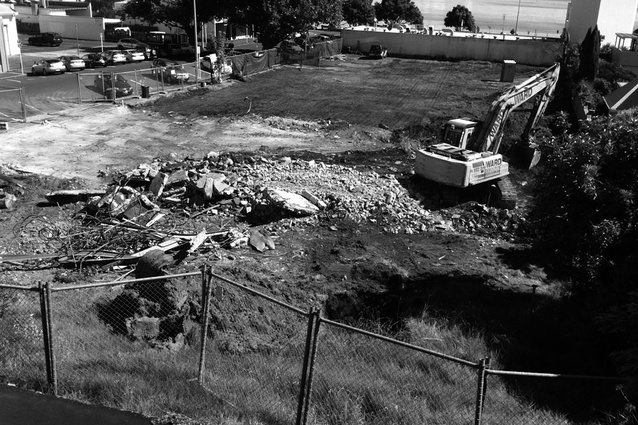Diggers at dawn
As the roar of the bulldozers subsides and the dust settles on the demolition of the "Art Deco" Spanish mission style houses in St Heliers, we report on the Environment Court's decision in Save Our St Heliers (SOS) v Ancona Properties and query whether that case makes destroying character buildings easier.
In early 201, SOS applied to the Court for an enforcement order to stop the demolition at the last minute, alleging that the destruction of the houses would be “objectionable” or “offensive”. The Court granted an interim order placing work on hold for a few weeks to allow a substantive hearing to take place. In the hearing, the main obstacle facing SOS was that a previous Auckland City Council Plan Change PM145 had labelled the houses at 8-12 Turua St as “character defining buildings” but had not afforded them any heritage protection under the ACC District Plan. SOS did not call any expert heritage evidence itself, and instead relied on a report prepared for the developers by heritage architect Adam Wild. This report noted that the houses at 8-12 Turua Street were:
“…particularly important in the context of St Heliers, contributing in two ways, firstly, contributing to and reinforcing the scale of Turua Street as a secondary street in the village, and secondly, and perhaps more importantly, playing a part in the wider understanding of St Heliers as a seaside village in its “garden city” planning heritage, by reference to whimsical nature, relationship with the sea, and character and contribution to the history of St Heliers.”
However, the report prophetically stated that, although the houses made a major contribution to the character of St Heliers, their loss would not change that character.
The Auckland Council was crucially the only party in the St Heliers case to present expert evidence, being that of Mr G Farrant, the Council’s Principal Heritage Advisor - Central, with many years of experience and recognition as a leading expert in the heritage area. Mr Farrant assessed the houses against heritage criteria and gave evidence that, whilst the houses were clearly of character significance to some members of the community, they did not rate protection in the District Plan as they achieved a low score against the heritage criteria.
In coming to his decision, Judge Newhook noted the importance of section 6(f) of the Resource Management Act - which provides for “the protection of historic heritage from an appropriate subdivision, use, and development”. He also examined the definition of “historical heritage” set out in that Act, which includes “architecture” but limits that with the words:
“…those natural and physical resources that contribute to an understanding and appreciation of New Zealand’s history and cultures…”
The Judge noted that there had been opportunities for the public to advocate for the protection of the Turua St houses in the past, such as submitting on Plan Change PM145 that they warranted some kind of heritage protection. Judge Newhook went on to find that, despite the fact that the buildings were much liked or even loved by a section of society, there was no expert evidence to indicate that the houses had significant value for the purposes of historic heritage.
As the Spanish mission style houses felt the full force of the developer’s wrecking machines, we investigated whether the St Heliers decision cleared the path for easier demolition of character buildings in this country. We do not think that this is the case.
Another, older case - Donnelly v Gisborne District Council - was considered by Judge Newhook in his decision above. This 1999 case concerned a set of “stripped classical” Edwardian style public toilets situated on a main street in Gisborne. Local businessman and unsuccessful mayoral candidate Thomas Donnelly sought to retain the toilet building and called three experienced architects who were all able to point to the historic and heritage value of the old toilets. These comprised the last known building designed by the famous engineer Mr J A McDonald, and as such were a key link between him and the
city of Gisborne.
The Court in Donnelly noted that the building was not accorded heritage status under the Gisborne District Plan, but that the Historic Places Trust had filed a submission for it to be so protected. The Court also placed weight on a survey which found that 43% of those polled felt the building had historic or heritage value, whilst 33% felt it was dated, obsolete and a traffic hazard, 23% sitting on the fence. The Court said this indicated that a significant proportion of the community considered the building to have sufficient heritage value to warrant its preservation, and held:
“I accordingly have no hesitation in concluding that to destroy a building which has significant heritage value or merit because of its special architectural and historical attributes could be offensive and objectionable to the community in that it is either undesirable, displeasing or open to objection and that such offence and objection could have an adverse effect on the environment contrary to the single purpose of the Act as set out in section 5.”
Judge Whiting, who is still an active member of the Environment Court bench, therefore granted an enforcement order prohibiting the Gisborne District Council from demolishing the toilets.
The Donnelly case puts the more recent St Heliers decision into context. Despite the anguish this situation created for Auckland Council’s newly elected mayor, the Turua St houses could not be protected as there simply was no expert evidence to indicate that the houses amounted to “historic heritage” for the purposes of protection under the RMA. The older Donnelly case indicates, however, that even when a building is not accorded heritage protection in a district plan, the Court may find that it is objectionable to demolish such a building where it can be proven through expert evidence that it has historic heritage qualities - and even when the building in question is a block of public toilets.










